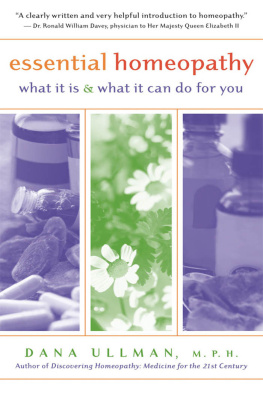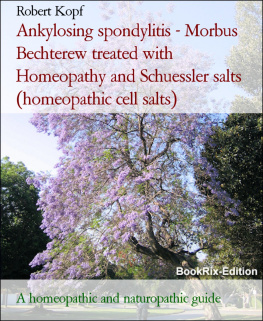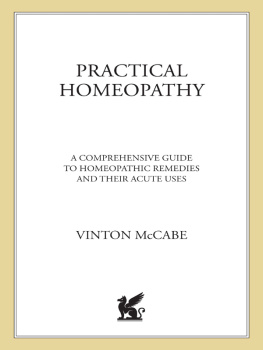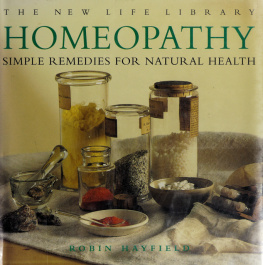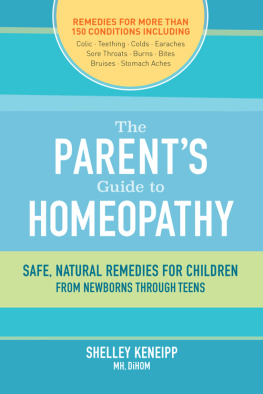Homeopathy for Babies
by Johannes Schn, M.D.
Translated by E.S. Dempsey
CONTENTS
Introduction
T he homeopathic treatment of babies is particularly promising and beneficial because an infants body gratefully and quickly responds to the remedies. A childs self-healing powers are supported, not suppressed, with this gentle method.
Infants are very receptive to the many sensory impressions around them, including homeopathic remedies. Prescribing for children is basically the same as for adults, although in infancy other aspects of the remedy picture come into play.
Dosages for homeopathic remedies
Its generally true for homeopathy that choosing the right drug is more important for success than the dosage. Nevertheless, some basic rules should be followed as to potency, frequency of administration, and duration of treatment. The remedies are available as globules (also called pellets), dilutions and tablets.
Dosages for infants
We use low potencies (D3, X3, D6, C6, X6, D12, C12, X12) in the following dosages for infants: Three globules (pellets) dissolved in the mouth three times a day. (In adults and older children the dosage is five globules.)
It makes no difference in principal whether a homeopathic remedy is taken in the form of drops, globules or tablets. Whats important is the information in the remedy more than how that information is delivered. However, drops contain alcohol and are therefore not recommended for babies.
A dosage of 3 globules is roughly equivalent to 3 drops or 1 tablet.
For all potencies higher than D30 (in the United States it is X30), a single dose of 3 globules will suffice. More than that can affect the impact of the remedy.
In very acute cases where we want the fastest possible action, 3 globules can be given immediately. Then dissolve 10 globules in half a glass of water (noncarbonated) and stir the remedy vigorously into the water, preferably with a plastic spoon. Give a half-teaspoonful of this solution every half-hour. Before each administration, briefly stir the remedy again. Once the symptoms improve, reduce the frequency of the dosage.
The C and D (X in the U.S.) potencies or the 6th and 12th potencies are interchangeable. Success comes mainly from choosing the right remedy.
The remedies are described in each section as follows:
Under the Remedy heading you will find a brief description of the remedy.
Then the guiding Symptoms of the remedy are briefly described. Choose the one remedy that has the greatest number of applicable symptoms.
If the reason for the ailment is clearly understood, this is listed separately under Cause .
Modalities are conditions that will cause the symptoms to improve (or get worse in certain circumstances). These often indicate the choice of remedy.
Specific Features are things that distinguish the remedy being described from other remedies, along with other information to help in your selection.
Childbirth
A baby spends nine months in a warm, dark, nourishing cave. At birth, the child must wriggle under the heavy muscle contractions of the uterus and turn to find an extremely narrow birth canal, then make its way through the mothers pelvic bones to the outside world.
Once the baby is out, it is exhausted, stressed, and often suffering an acute, life-threatening lack of oxygen. The baby needs to start breathing immediately.
If the newborn finds a darkened, warm and loving environment, this difficult time can be confidently forgotten. Mother and child will get to know and be attuned to each other in the coming weeks.
Alone in this new and strange world, a baby has no other option than to rely on others.
The newborn has heard the voice of her mother while still in the womb and will recognize that familiar sound again. Soon the baby will recognize her nearest caregivers, including father, grandparents and siblings by voice, by scent, and only later by their faces. In this familiar environment the infant grows, develops skills, and makes its way into conscious human existence.
From a homeopathic perspective, the time immediately after birth is very formative for the childs healthy stability and later attitudes towards life. A newborn babys life force, apart from genetic factors, is like a blank sheet of paper. These first life experiences and sense impressions will imprint themselves deeply into the childs psychological layers.
Disturbances to the babys vital energy in the earliest stages of life are imprinted on its consciousness. Even if these memories are not accessible in adulthood, their influence is nonetheless substantial, and they can later result in mental and physical problems. In this respect, the birth and the period immediately after it are of great importance homeopathically.
Unfortunately, birth is not always a harmonious event. Some of the health risks associated with giving birth (for both mother and child) are as follows:
The human skull is very large and there is a risk that the child will get stuck in the mothers birth canal during delivery. The birth canal consists of the uterus, the cervix and the vagina. The child can be overcome by the journey through the extremely narrow path between the mothers pelvic bones, which can only be accomplished by a complex twist and turn.
The baby makes its way through the birth canal on its head, where the skull bones have to push apart the close passageway. As a result of the extreme pressure on the babys exposed head, there may be bruises (cephalohematoma) on the skull.
During the last weeks of pregnancy, the baby makes a complex rotation. The head, which in the majority of cases was previously located upwards, must now come down. So during a normal birth the child is upside down.
If this rotation is not completed in time for the birth, the baby comes into a breech position, where the pelvis instead of the head moves first into the birth canal. There is a great danger that the child will get stuck in the mothers pelvis because its head has a larger circumference than the rest of its body.
The umbilical cord might get caught around the babys throat and be tightened by a pull on it, cutting off the babys blood supply. This could cause injury and even death by strangulation if action isnt quickly taken. Fortunately, this threatening situation can be resolved quickly nowadays with a Caesarean section.
The mothers pelvis may be too narrow for the baby to birth normally. However now the mothers pelvis is routinely measured with an ultrasound examination, and a Caesarean section can be performed if the pelvis is too narrow.
There are many other birth complications that we wont go into here. Much can be explained by the fact that over the course of evolution humans developed larger skulls to accommodate their larger brains, and with this came an increasingly risky birth process. Along with the development of our intellect, mankinds transformation to walking upright also altered the shape of the human pelvis.
Homeopathic remedies for childbirth
Pre-birth and during labor
Chamomilla
R emedy
Chamomile is native to Europe and Asia. It is used fresh, with the whole plant being collected at the time of flowering.
Symptoms
Contractions seem unbearable
Pain descending from the back down to the inner thighs
Great restlessness and nervous tension; weeping
Spasmodic pain
Modalities
Improves when walking about
Improves with moist heat
Specific Features
Important remedy for easing the pain of childbirth
Caulophyllum
R emedy
Blue Cohosh is native to North America and is used in traditional herbal medicine.
Symptoms
Spasms of the uterus
Next page


